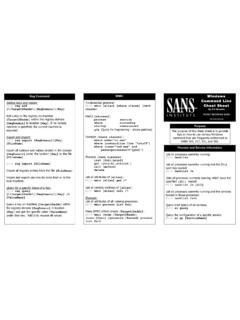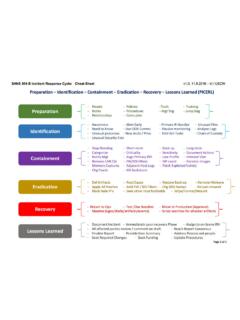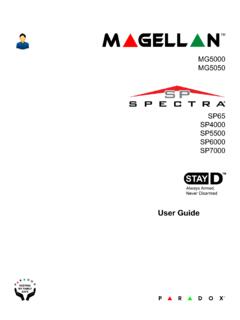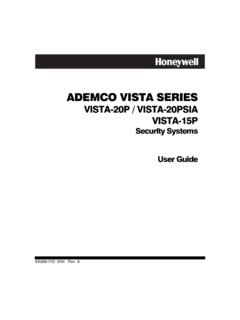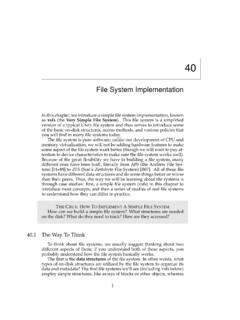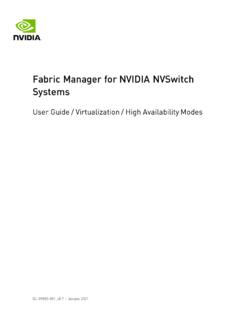Transcription of Operating System Installation Guidelines - SANS Institute
1 A - 1 Operating System Installation Guidelines The following document guides you step-by-step through the process of installing the Operating systems so they are properly configured for boot camp. The document is divided into 3 parts: 1. Windows XP Installation 2. Linux Installation 3. VMWare Installation Option 1: If you are going to use a bootable Knoppix CD for the Linux portion, you only need to install Windows XP and follow section 1. For Windows XP you want to perform a full default install of all components. It is critical that you use Windows XP Professional, Windows XP Home Edition will NOT work. You also want to make sure that Service Pack 2 is installed. For Knoppix, please download and boot off of the Knoppix CD prior to coming to class to validate that Knoppix supports your hardware.
2 The version of Knoppix that we will use for class can be found at Option 2: If you are going to use VMWare for Linux follow steps 1 and 3. For Windows XP you want to perform a full default install of all components. It is critical that you use Windows XP Professional as Windows XP Home Edition will NOT work. You also want to make sure that Service Pack 2 is installed. It is critical that you install and test VMWare with Knoppix prior to coming to class. The version of Knoppix that we will use for class can be found at Option 3: If you are going to use a dual boot System and install both Windows XP and Linux, follow steps 1 and 2. For Windows XP you want to perform a full default install of all components. It is critical that you use Windows XP Professional, Windows XP Home Edition will NOT work.
3 You also want to make sure that Service Pack 2 is installed. For Linux you want to make sure you install all components. Prior coming to class install and run Nessus to confirm that all of the components have been properly installed for Linux. If you do not install the proper configuration, some of the exercises might not work. Windows XP Installation It is important to understand that this guide was specifically designed for a lab environment. There are a lot of Operating System vulnerabilities that are intentionally left unpatched in these Installation steps. This is intentionally done to give you the best results when completing the labs and tutorials in this book. If you are interested, a great reference for building a Windows XP Professional box that is secure enough for a production environment is Windows XP Security: Step By Step by sans .
4 A - 2 To create a properly configured laptop for the Security Essentials Boot Camp, follow the detailed steps in this document from the initial setup screen to the final login. This guide was designed for use on a System that doesn't already have a Windows platform installed on it. If your machine does not have a blank hard drive, some of the screens you see at the beginning of the Installation may be different from what you see in this chapter. If different screens appear, it is important that you always choose the option to replace, or overwrite. Do not choose to upgrade. The Windows install should also be placed in the default c:\windows directory. Creating Boot Disks If your System does not support the capability to boot off of a CD-ROM, you can use the Windows XP boot disk to boot.
5 If you do not have a set of the four disks, you need to use a machine that already has Windows XP Professional installed on it. The following steps show you how to create the four boot disks: 1. Label four blank, formatted, , floppy disks as: Setup Disk One, Setup Disk Two, Setup Disk Three, and Setup Disk Four. 2. Insert Setup Disk One into the floppy disk drive of a Windows or DOS System . 3. Insert the Windows XP CD-ROM into the CD-ROM drive. 4. Click Start, and then click Run. 5. In the Open box, type D:\bootdisk\makeboot a: (where D: is the drive letter assigned to your CD-ROM drive), and then click OK. 6. Follow the screen prompts. 7. After you have completed the screen prompt requests, insert Setup Disk One into the floppy disk drive of the lab PC and power the PC on.
6 Booting from the CD-ROM A - 3 If your System supports booting off of the CD-ROM, you do not need to use the disks previously discussed. Instead, follow these steps: 1. Simply start by placing the Windows XP CD-ROM into your CD tray and power on your machine. The first non-blank screen you should see is the one shown in the following illustration. A - 4 2. If the previous screen does not appear, reboot your machine and open up the BIOS. You need to make the System boot to the CD-ROM first. The following screen is one of several different BIOSes you could have on your System . You need to navigate to a screen that allows you to change the Boot Order. This is where you tell it to boot off of the CD-ROM. A - 5 3.
7 Now your System should boot off of the CD-ROM. After a period of time (typically 30-45 seconds), the following screen appears. Because we are doing an initial install, you only need to press Enter to continue. 4. Hit Enter at the next screen to continue Installation . A - 6 5. The Microsoft Windows XP Licensing Agreement appears next, as shown in the following screen. It is important that you read and understand this agreement before continuing with the Installation . After you have read and agreed to the contents of the license, press F8 to continue. Defining Drive partitions You now need to define the drive partitions . Defining your drive partitions is used instead of FDISK. When defining your drive partitions , it is extremely important that you leave enough space for your Linux partition!
8 Following are the steps: 1. Press C to create a partition for your Windows install. 2. You need a minimum of 2Gb of space for each of your Operating systems. When you are prompted for the size of the partition, enter a number that is equal to 50 percent of your available hard drive space. Then, highlight the partition, which should be labeled Unpartitioned space (see the following illustration), and press C. Note: If partitions already exist they should be deleted. However you should realize that this will permanently remove any data that is currently on your System . A - 7 Now create your new partition to be at least 2 Gb. In the provided space type 2047 and press Enter A - 8 You should now see two partitions .
9 Verify that the new 2047 partition is highlighted and press Enter. Formatting Drive partitions The next step is to format your partition. For security reasons, you should format your partitions using NTFS. NTFS is a Windows partition type that allows you to assign permissions at the folder level. This level of granularity is not the same for FAT partitions . NTFS also allows for lager partition sizes compared to the 2Gb limit that comes with FAT16. The steps for formatting your partition follow: A - 9 1. Highlight the NTFS <Quick> partition option as shown in the following screen, and press Enter. 2. After you press Enter, the System formats the partition, as shown in the following screens. Depending on the size of the partition, this step can take from 5 minutes to an hour.
10 This is a great time to refill your caffeine-laced beverage of choice. (You may need it because you have a long way to go.) A - 10 Since this will take a while you should just wait while this process continues. When you return to your machine, you may see one of the following screens. Don't be alarmed. The System has completed the formatting process and has automatically rebooted. After this occurs, you have to answer the remaining install questions. A - 11 A - 12 Customizing Your System Now Windows presents a series of questions, which, when answered, customize your System . The following steps walk you through the process of customizing your System : 1. Typically, you only need to make changes during the next step (see the following screen) if you are located outside of the United States or if you use a non-standard keyboard.
